
2002.12 tENTATIVELY, a cONVENIENCE interviewed by aundre-g (Aundre Gandy) for his "Strike" zine.
[interviewee's note: I've worked as a projectionist / A/V technician for the Andy Warhol Museum since December of 1996. It's the longest lasting job I've ever had. Despite whatever complaints I have about the attendant poverty & deliberate lack of advancement opportunities imposed by people who should be less selfish (but aren't), it can be a great place for meeting kindred spirits.
aundre-g was one of them - as so many of them are / were (especially in the earlier days). aundre-g approached me about this interview which we then conducted in the projection booth. He was on his 15 minute break - which he then extended to about 30 to 45 minutes to accommodate finishing the interview. While he was still there, a somewhat understandably irate Gallery Attendant supervisor angrily came to get him. aundre-g has long since moved on, the supervisor has long since moved up. Such is life.
I include scans of the original lo-fi product & some relevant photos of somewhat higher quality.]

photograph at Coney Island by Johnny Evans
INTERVIEW: tENTATIVELY, a cONVENIENCE & aundre-g
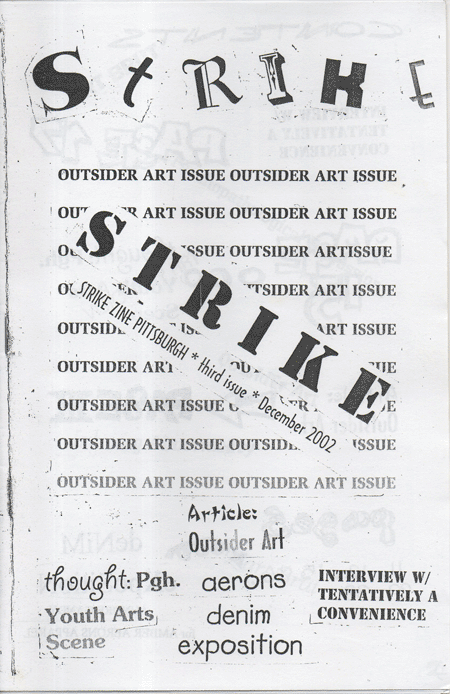
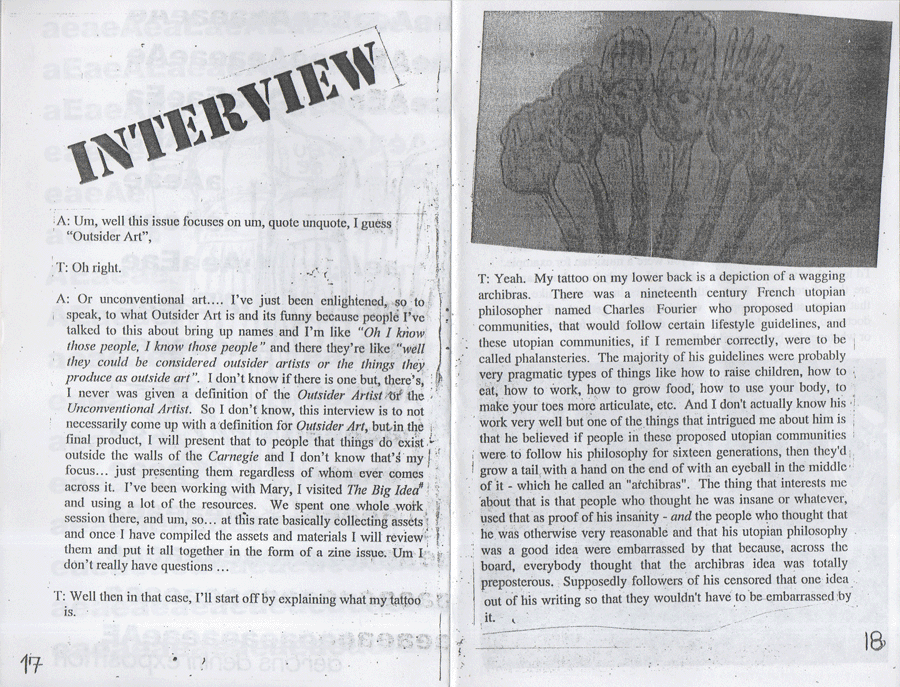
T: Anyway, what did you want to interview me about?
A: Um, well this issue focuses on um, quote unquote, I guess "Outsider Art",
T: Oh right.
A: Or unconventional art. I've just been enlightened, so to speak, to what Outsider Art is and it's funny because people I've talked to this about bring up names and I'm like "Oh I know those people, I know those people" and there they're like "well they could be considered outsider artists or the things they produce as outside art". I don't know if there is one but, there's, I never was given a definition of the Outsider Artist or the Unconventional Artist. So I don't know, this interview is to not necessarily come up with a definition for Outsider Art, but in the final product, I will present that to people that things do exist outside the walls of the Carnegie and I don't know that's my focus just presenting them regardless of whom ever comes across it. I've been working with Mary, I visited The Big Idea and using a lot of the resources. We spent one whole work session there, and um, so at this rate basically collecting assets and once I have compiled the assets and materials I will review them and put it all together in the form of a zine issue. Um I don't really have questions.
T: Well then in that case, I'll start off by explaining what my tattoo is.
A: your tattoo, about the hands.
T: Yeah. My tattoo on my lower back is a depiction of a wagging archibras. There was a nineteenth century French utopian philosopher named Charles Fourier who proposed utopian communities, that would follow certain lifestyle guidelines, and these utopian communities, if I remember correctly, were to be called phalansteries. The majority of his guidelines were probably very pragmatic types of things like how to raise children, how to eat, how to work, how to grow food, how to use your body, to make your toes more articulate, etc. And I don't actually know his work very well but one of the things that intrigued me about him is that he believed if people in these proposed utopian communities were to follow his philosophy for sixteen generations, then they'd grow a tail with a hand on the end of it with an eyeball in the middle of it - which he called an "archibras". The thing that interests me about that is that people who thought he was insane or whatever, used that as proof of his insanity - and the people who thought that he was otherwise very reasonable and that his utopian philosophy was a good idea were embarrassed by that because, across the board, everybody thought that the archibras idea was totally preposterous. Supposedly followers of his censored that one idea out of his writing so that they wouldn't have to be embarrassed by it.
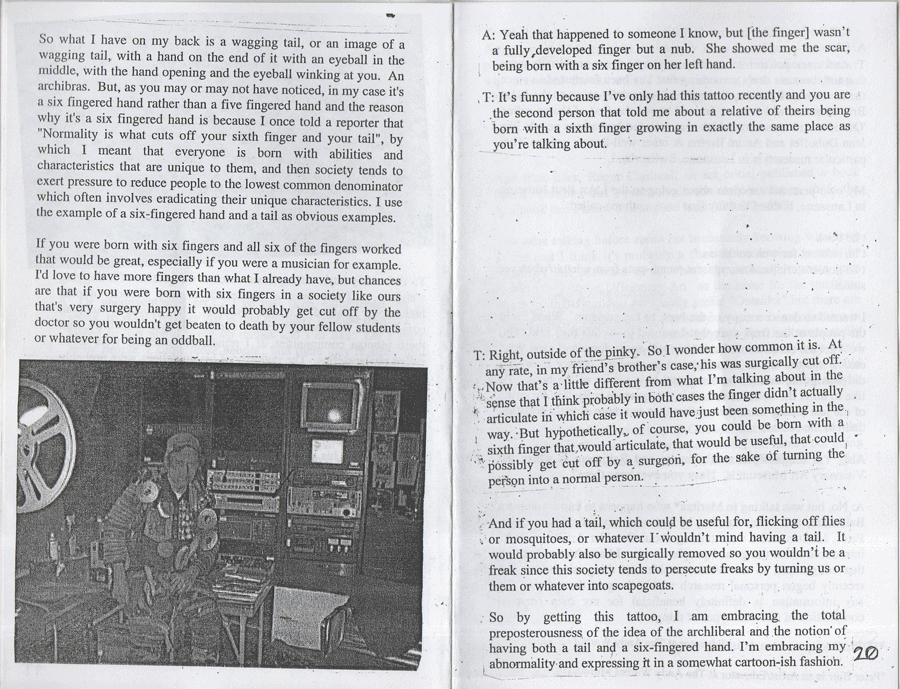
So what I have on my back is a wagging tail, or an image of a wagging tail, with a hand on the end of it with an eyeball in the middle, with the hand opening and the eyeball winking at you. An archibras. But, as you may or may not have noticed, in my case it's a six fingered hand rather than a five fingered hand and the reason why it's a six fingered hand is because I once told a reporter that "Normality is what cuts off your sixth finger and your tail", by which I meant that everyone is born with abilities and characteristics that are unique to them, and then society tends to exert pressure to reduce people to the lowest common denominator which often involves eradicating their unique characteristics. I use the example of a six-fingered hand and a tail as obvious examples.
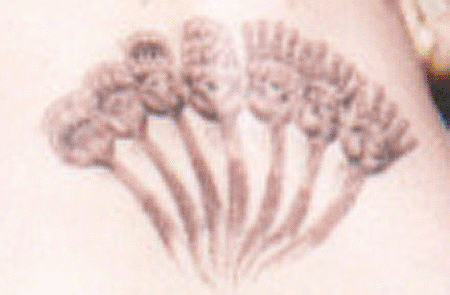
If you were born with six fingers and all six of the fingers worked that would be great, especially if you were a musician for example. I'd love to have more fingers than what I already have, but chances are that if you were born with six fingers in a society like ours that's very surgery happy it would probably get cut off by the doctor so you wouldn't get beaten to death by your fellow students or whatever for being an oddball.
A: Yeah that happened to someone I know, but [the finger] wasn't a fully developed finger but a nub. She showed me the scar, being born with a six finger on her left hand.
T: It's funny because I've only had this tattoo recently and you are the second person that told me about a relative of theirs being born with a sixth finger growing in exactly the same place as you're talking about. In the 1st case, the person was a friend's brother.
A: Outside of the pinky.
T: Right, outside of the pinky. So I wonder how common it is. At any rate, in my friend's brother's case, his was surgically cut off. Now that's a little different from what I'm talking about in the sense that I think probably in both cases the finger didn't actually articulate in which case it would have just been something in the way. But hypothetically, of course, you could be born with a sixth finger that would articulate, that would be useful, that could possibly get cut off by a surgeon, for the sake of turning the person into a so-called 'normal' person.
And if you had a tail, it could be useful for flicking off flies or mosquitoes or whatever. I wouldn't mind having a tail. It would probably also be surgically removed so you wouldn't be a freak since this society tends to persecute freaks by turning us or them into scapegoats.
So, by getting this tattoo, I'm embracing the total preposterousness of the idea of the archibras and the notion of having both a tail and a six-fingered hand. I'm embracing my abnormality and expressing it in a somewhat cartoon-ish fashion.
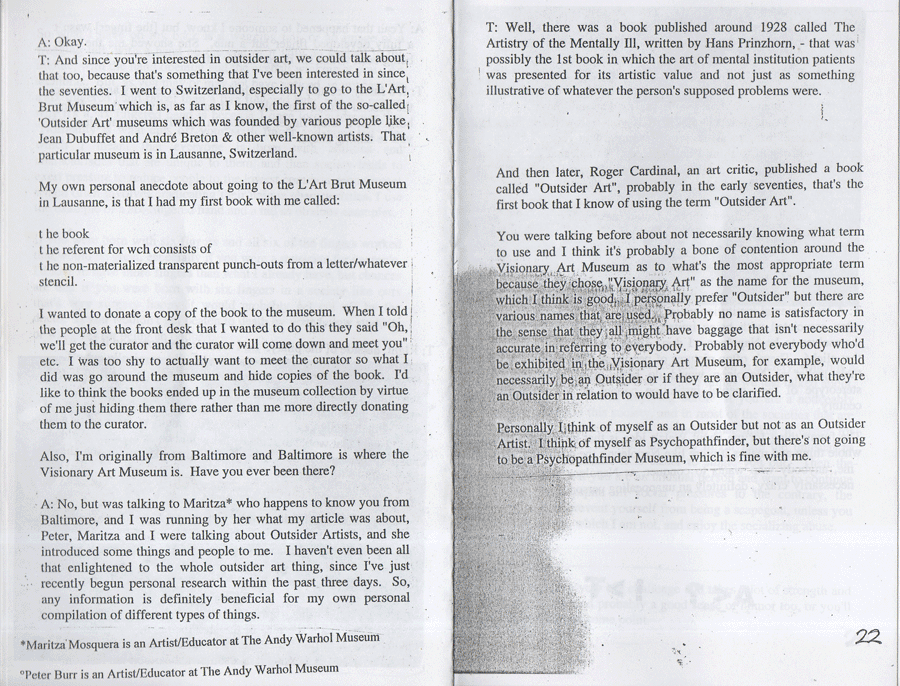
A: Okay.
T: And since you're interested in outsider art, we could talk about that too, because that's something that I've been interested in since the seventies. I went to Switzerland, especially to go to the L'Art Brut Museum which is, as far as I know, the first of the so-called 'Outsider Art' museums which was founded by various people like Jean Dubuffet and André Breton & other well-known artists. That particular museum is in Lausanne, Switzerland.
My own personal anecdote about going to the L'Art Brut Museum in Lausanne, is that I had my first book with me called:
t he book
t he referent for wch consists of
t he non-materialized transparent punch-outs from a letter/whatever stencil.
I wanted to donate a copy of the book to the museum. When I told the people at the front desk that I wanted to do this they said "Oh, we'll get the curator and the curator will come down and meet you" etc. I was too shy to actually want to meet the curator so what I did was go around the museum and hide copies of the book. I'd like to think the books ended up in the museum collection by virtue of me just hiding them there rather than me more directly donating them to the curator.
Also, I'm originally from Baltimore and Baltimore is where the Visionary Art Museum is. Have you ever been there?
A: No, but was talking to Maritza* who happens to know you from Baltimore, and I was running by her what my article was about, Peter, Maritza and I were talking about Outsider Artists, and she introduced some things and people to me. I haven't even been all that enlightened to the whole outsider art thing, since I've just recently begun personal research within the past three days. So, any information is definitely beneficial for my own personal compilation of different types of things.
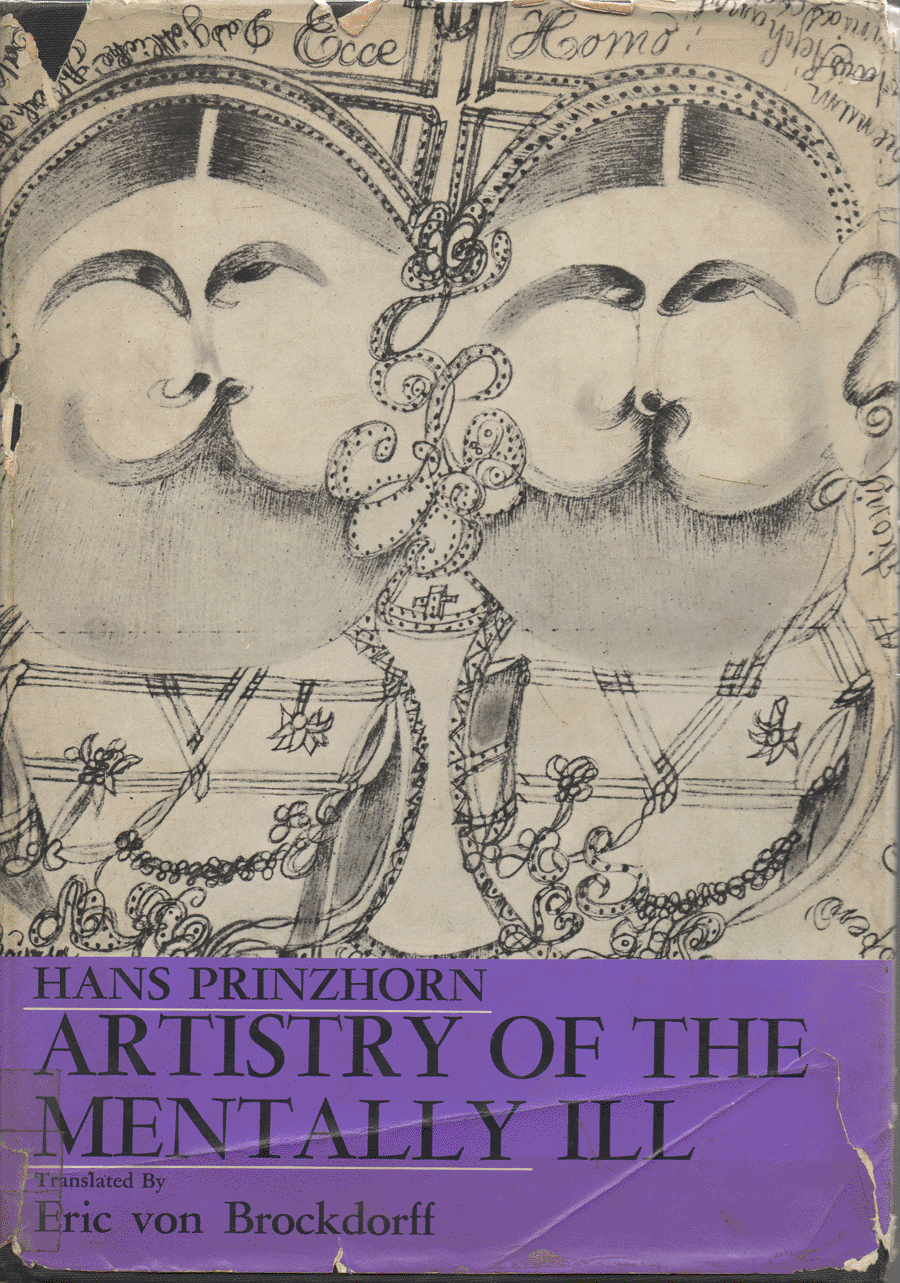
T: Well, there was a book published around 1928 called The Artistry of the Mentally Ill, written by Hans Prinzhorn, - that was possibly the 1st book in which the art of mental institution patients was presented for its artistic value and not just as something illustrative of whatever the person's supposed problems were.
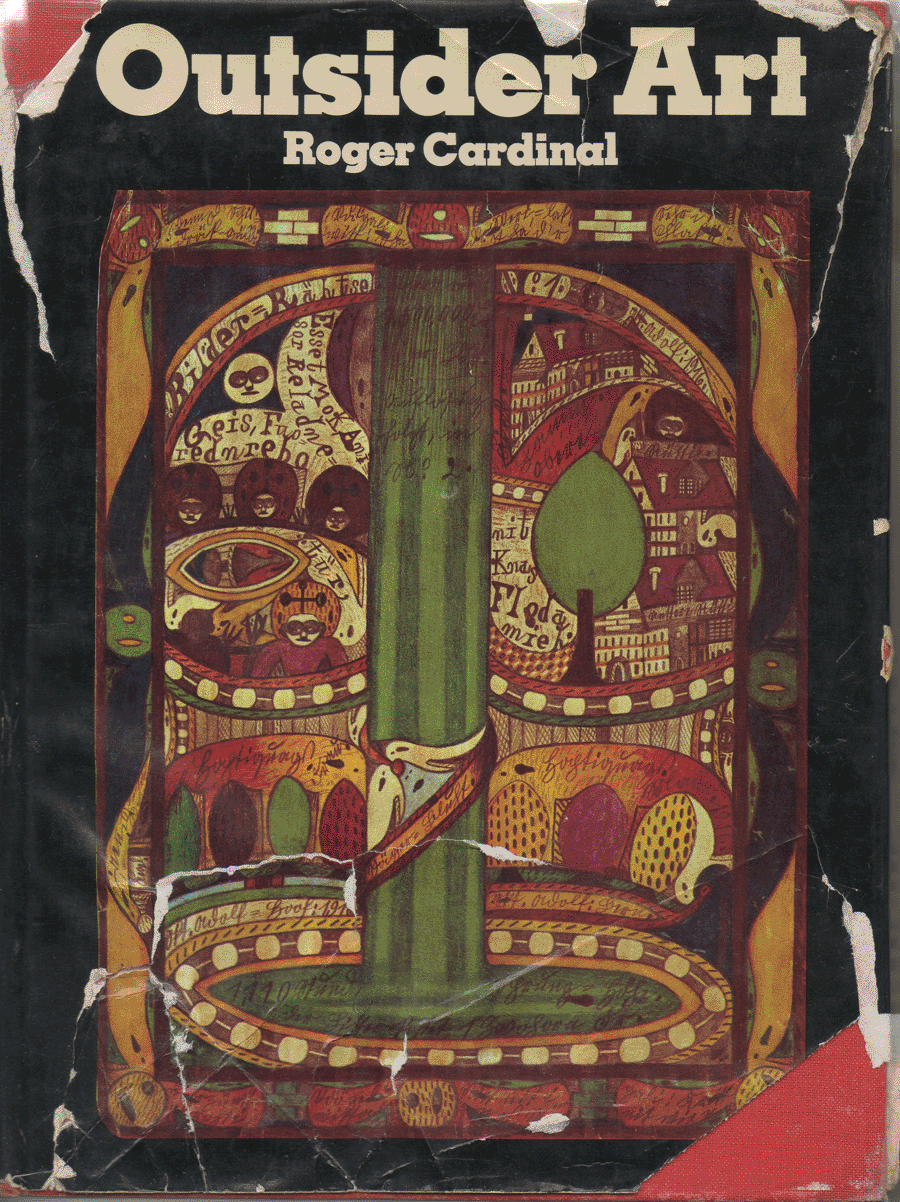
And then later, Roger Cardinal, an art critic, published a book called "Outsider Art", probably in the early seventies, that's the first book that I know of using the term "Outsider Art".
You were talking before about not necessarily knowing what term to use and I think it's probably a bone of contention around the Visionary Art Museum as to what's the most appropriate term because they chose "Visionary Art" as the name for the museum, which I think is good. I personally prefer "Outsider" but there are various names that are used. Probably no name is satisfactory in the sense that they all might have baggage that isn't necessarily accurate in referring to everybody. Probably not everybody who'd be exhibited in the Visionary Art Museum, for example, would necessarily be an Outsider or if they are an Outsider, what they're an Outsider in relation to would have to be clarified.
Personally I think of myself as an Outsider but not as an Outsider Artist. I think of myself as a Psychopathfinder, but there's not going to be a Psychopathfinder Museum, which is fine with me.
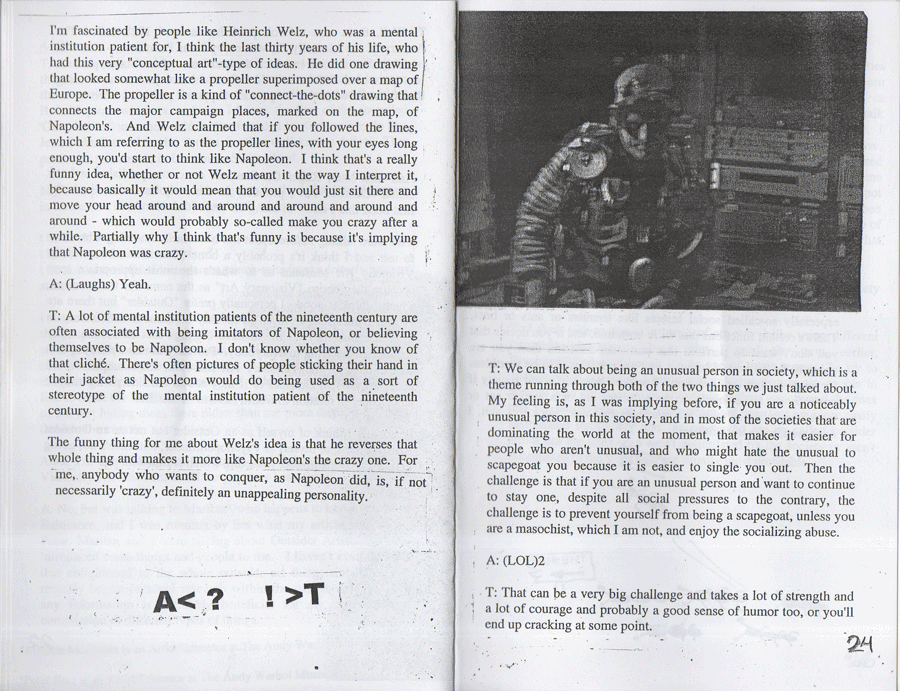
I'm fascinated by people like Heinrich Welz, who was a mental institution patient for, I think the last thirty years of his life, who had this very "conceptual art"-type of ideas. He did one drawing that looked somewhat like a propeller superimposed over a map of Europe. The propeller is a kind of "connect-the-dots" drawing that connects the major campaign places, marked on the map, of Napoleon's. And Welz claimed that if you followed the lines, which I am referring to as the propeller lines, with your eyes long enough, you'd start to think like Napoleon. I think that's a really funny idea, whether or not Welz meant it the way I interpret it, because basically it would mean that you would just sit there and move your head around and around and around and around and around - which would probably so-called make you crazy after a while. Partially why I think that's funny is because it's implying that Napoleon was crazy.
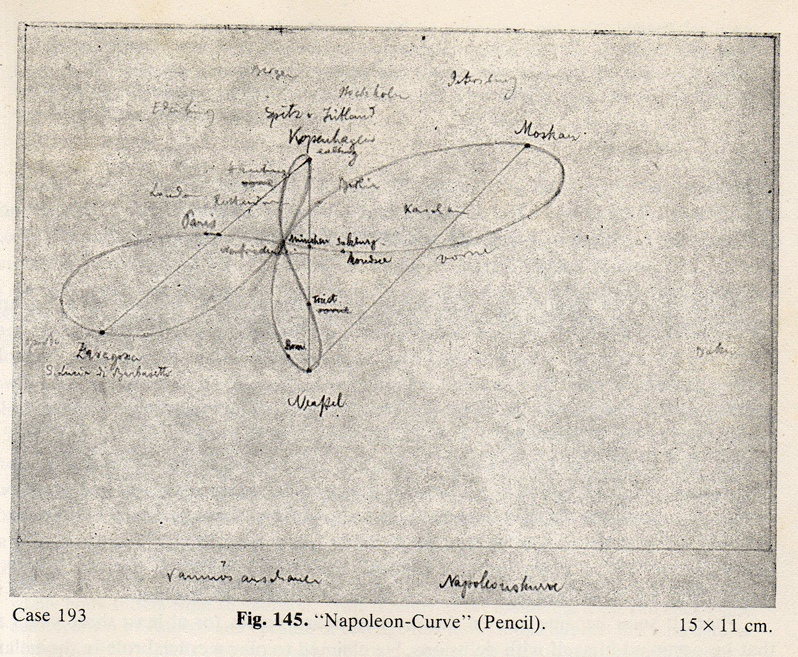
A: (Laughs) Yeah.
T: A lot of mental institution patients of the nineteenth century are often associated with being imitators of Napoleon, or believing themselves to be Napoleon. I don't know whether you know of that cliché. There's often pictures of people sticking their hand in their jacket as Napoleon would do being used as a sort of stereotype of the mental institution patient of the nineteenth century.
The funny thing for me about Welz's idea is that he reverses that whole thing and makes it more like Napoleon's the crazy one. For me, anybody who wants to conquer, as Napoleon did, is, if not necessarily 'crazy', definitely an unappealing personality.
T: We can talk about being an unusual person in society, which is a theme running through both of the two things we just talked about. My feeling is, as I was implying before, if you are a noticeably unusual person in this society, and in most of the societies that are dominating the world at the moment, that makes it easier for people who aren't unusual, and who might hate the unusual to scapegoat you because it is easier to single you out. Then the challenge is that if you are an unusual person and want to continue to stay one, despite all social pressures to the contrary, the challenge is to prevent yourself from being a scapegoat, unless you are a masochist, which I am not, and enjoy the socializing abuse.
A: (LOL)2
T: That can be a very big challenge and takes a lot of strength and a lot of courage and probably a good sense of humor too, or you'll end up cracking at some point.
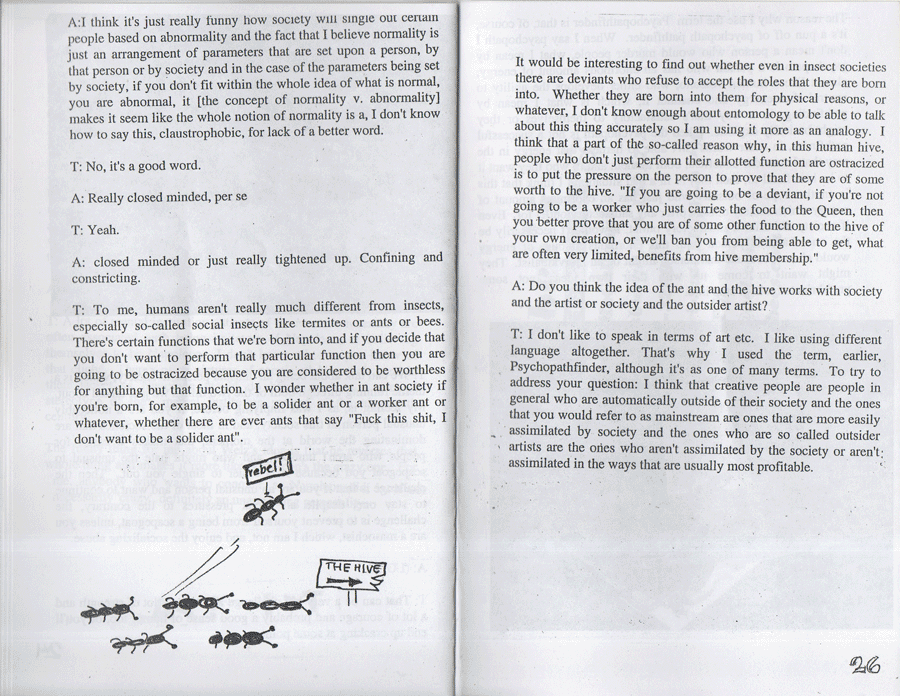
A: I think it's just really funny how society will single out certain people based on abnormality and the fact that I believe normality is just an arrangement of parameters that are set upon a person, by that person or by society and in the case of the parameters being set by society, if you don't fit within the whole idea of what is normal, you are abnormal, it [the concept of normality v. abnormality] makes it seem like the whole notion of normality is a, I don't know how to say this, claustrophobic, for lack of a better word.
T: No, it's a good word.
A: Really closed minded, per se
T: Yeah.
A: closed minded or just really tightened up. Confining and constricting.
T: To me, humans aren't really much different from insects, especially so-called social insects like termites or ants or bees. There's certain functions that we're born into, and if you decide that you don't want to perform that particular function then you are going to be ostracized because you are considered to be worthless for anything but that function. I wonder whether in ant society if you're born, for example, to be a soldier ant or a worker ant or whatever, whether there are ever ants that say "Fuck this shit, I don't want to be a soldier ant".
It would be interesting to find out whether even in insect societies there are deviants who refuse to accept the roles that they are born into. Whether they are born into them for physical reasons, or whatever, I don't know enough about entomology to be able to talk about this thing accurately so I am using it more as an analogy. I think that a part of the so-called reason why, in this human hive, people who don't just perform their allotted function are ostracized is to put the pressure on the person to prove that they are of some worth to the hive. "If you are going to be a deviant, if you're not going to be a worker who just carries the food to the Queen, then you better prove that you are of some other function to the hive of your own creation, or we'll ban you from being able to get, what are often very limited, benefits from hive membership."
A: Do you think the idea of the ant and the hive works with society and the artist or society and the outsider artist?
T: I don't like to speak in terms of art etc. I like using different language altogether. That's why I used the term, earlier, Psychopathfinder, although it's as one of many terms. To try to address your question: I think that creative people are people in general who are automatically outside of their society and the ones that you would refer to as mainstream are ones that are more easily assimilated by society and the ones who are so called outsider artists are the ones who aren't assimilated by the society or aren't assimilated in the ways that are usually most profitable.

The reason why I use the term Psychopathfinder is that, of course, it's a pun off of psychopath pathfinder. When I say psychopath I don't mean a person who would murder people, what I mean by psychopath is a person who has an enormous amount of energy, almost like a human volcano, who either develops the ability to control that energy and channel it, which is what I mean by pathfinding, in a way that's satisfactory to themselves or they might basically explode. When the psychopath is not a successful pathfinder, in other words isn't able to harness that energy in the way that I consider beneficial both to them and to who they want it to be beneficial to, then they're in a bad situation. I think that this is another type of outsider who just has an enormous amount of energy which society doesn't offer any satisfactory outlet for. Even if society did offer a satisfactory outlet, it wouldn't necessarily be the one that this person with this enormous amount of energy would choose because that person might be an individualist. They might want to come up with their own ideas, not some prefabricated role to step into.
godspeed
-ALG
idioideo at verizon dot net
to the tENTATIVELY, a cONVENIENCE as Interviewee page
to the tENTATIVELY, a cONVENIENCE as Interviewer index
to the tENTATIVELY, a cONVENIENCE movie-making "Press: Criticism, Interviews, Reviews" home-page
to the "tENTATIVELY, a cONVENIENCE - Sprocket Scientist" home-page
to the "FLICKER" home-page for the alternative cinematic experience
to find out more about why the S.P.C.S.M.E.F. (Society for the Prevention of Cruelty to Sea Monkeys by Experimental Filmmakers) is so important
for info on tENTATIVELY, a cONVENIENCE's tape/CD publishing label: WIdémoUTH
to see an underdeveloped site re the N.A.A.M.C.P. (National Association for the Advancement of Multi-Colored Peoples)